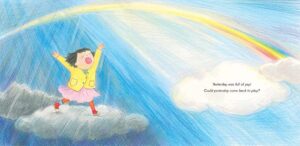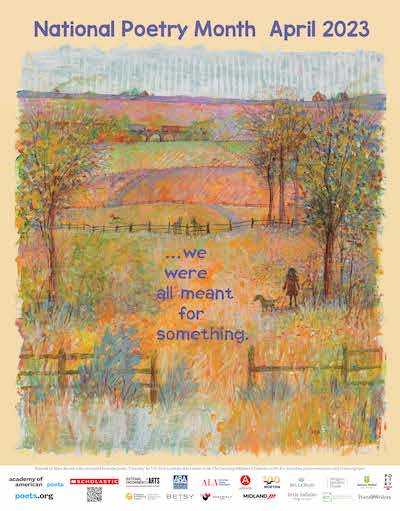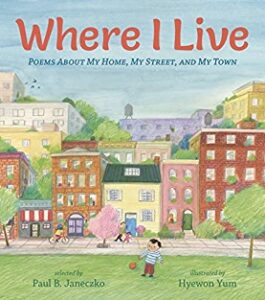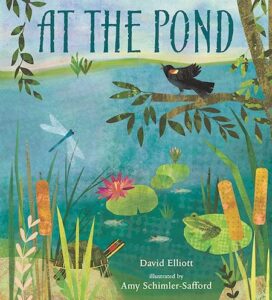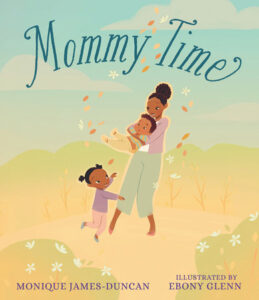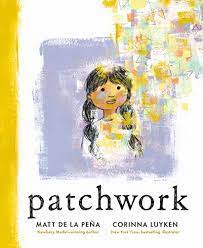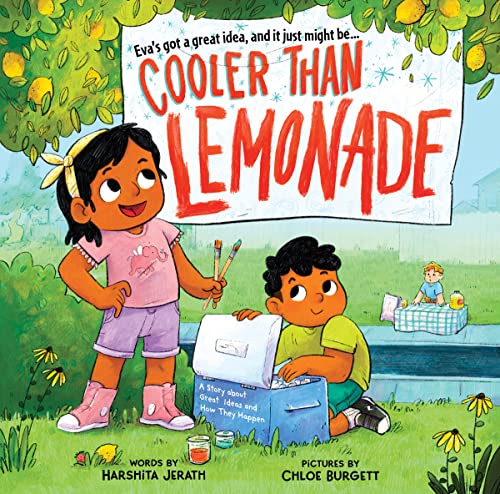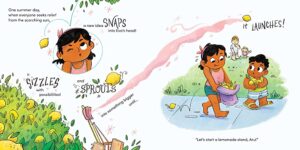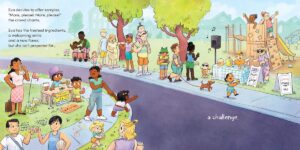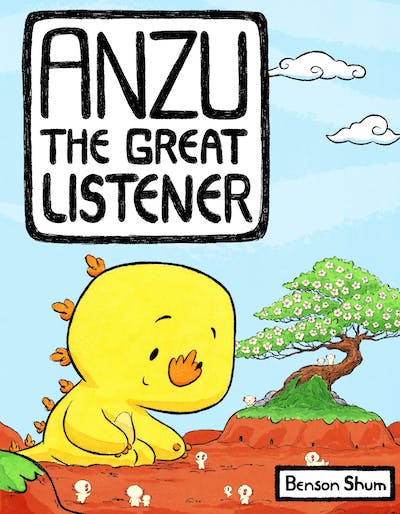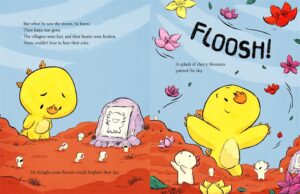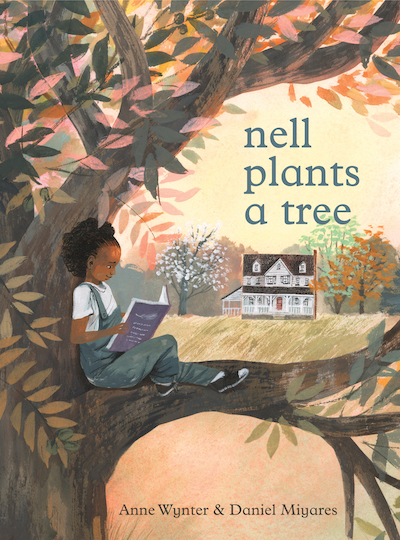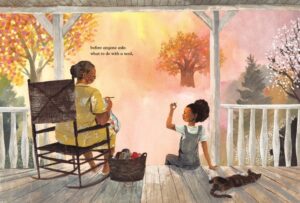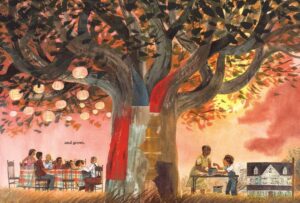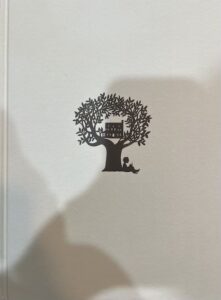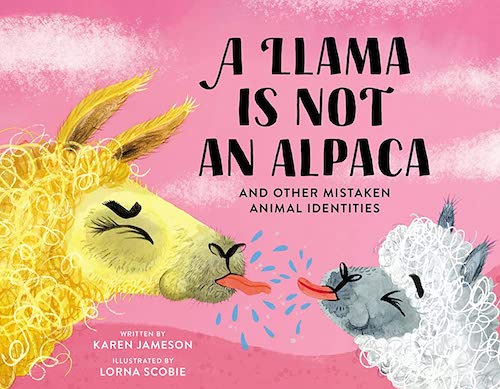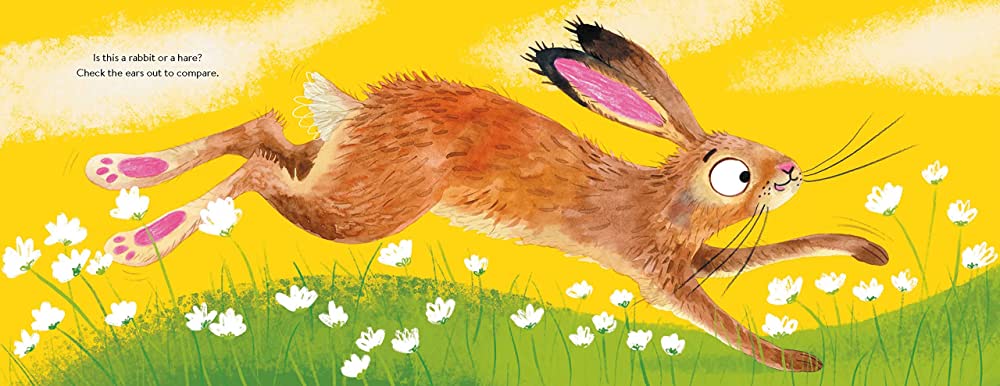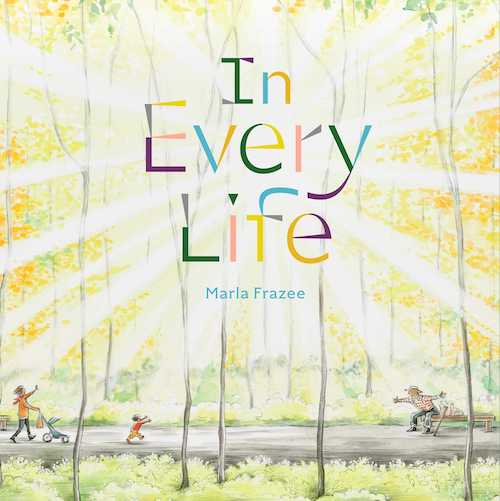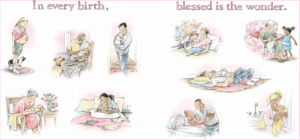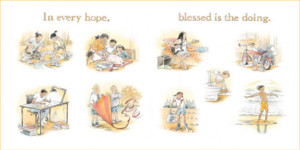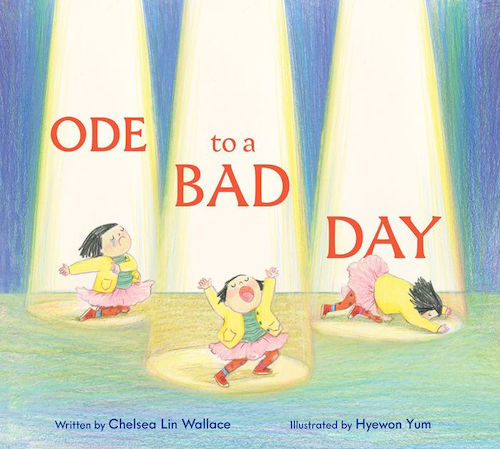
Chronicle Books | 978-1797210803
We’ve all had our share of bad days. Times when nothing goes our way. We’re late, we’re bored, someone cuts in line, even dinner disappoints. It feels like the whole wide world has turned against us.
Then, just when we think we won’t be able to stand another minute of it, this happens…
“Oh Cricket in My Room.
cheet-cheet-cheet, cheet-cheet, cheet-cheet.
A bleaty tweet with insect feet!
You’re up, you’re down, you’re all around
I can’t escape your cheet-y sound!
Oh you Cricket!”
Could things get any worse? And then… well, you put things in perspective. Not every day will be like this one, right?
“Oh, Bad Day,
all day long
my way went wrong.
I’m so annoyed…
but not destroyed…
…My eyes are closed, and I suppose
a better day is on its way.”
It’s impossible not to smile. Sure, we’re all seen bad days, but – somehow or other – things eventually turn around.
With charming verse by Chelsea Lin Wallace, ODE TO A BAD DAY takes the sting out of the kinds of everyday annoyances we’ve all experienced. Hyewon Yum‘s sweet illustrations, rendered in watercolor and colored pencil, capture the emotional journey of the young protagonist while leaning into the undercurrent of humor that bubbles up and emerges by the book’s end.
ODE TO A BAD DAY is sure to remedy even the worst days and remind readers that a new and better day is just around the corner.
***
DIANNE: Welcome, Chelsea! Thanks for agreeing to answer a few questions about your newest book!
CHELSEA: Thank you for having me, Dianne! It’s such a pleasure to get to interview with you – my agent sister!
DIANNE: One definition I found described an ode as a form of lyric poetry that expresses emotion and represents the poet’s musings on a thing (or person). ODE TO A BAD DAY is exactly that, Lots of emotions about all the bumpy moments your sweet protagonist encounters in a day. I imagine you had fun coming up with those moments – from rusty bones to dusty teeth, soggy, squishy cereal to stinging knees. We’ve all had those kinds of day, even as we can’t help but smile at the young girl’s dramatic hyperbole. As writers, we know that inspiration for stories can be found just about anywhere. What was the spark that inspired this ODE?
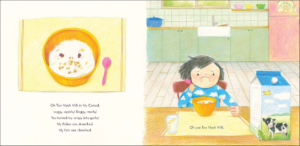
CLICK TO ENLARGE © Words by Chelsea Lin Wallace, illustrations by Hyewon Yum
CHELSEA: I will give you a hint: cheet-cheet-cheet! Oh, that cricket! My daughter was 7 yo when she was visited by a chirping cricket in her room and she couldn’t figure out where it was coming from. The DRAMA! She was furious and frustrated and we ended up tearing apart her room looking but we still couldn’t find the guy. After a while her anger turned into giggles because of how ridiculous the whole night had become. I started paying close attention to all the tiny and tremendous annoying moments in her day and the story unfolded. I knew I wanted to flip the ode on its head – essentially ode-ing to the moments we don’t like – because in many ways we can be just as grateful for the moments that challenge us as the ones that lift us.
DIANNE: What I love so much about your story is the way it makes space for the young protagonist to vent all manner of her complaints. At the same time, we – as readers – can’t help but feel our spirits lift at the humor of it all. Sometimes a missing pudding cup and yucky, slimy sauce on our spaghetti is the worst! Ha!
Do you have a favorite best “worst moment” that you knew you wanted to include? Were there some moments that were part of the drafting process that you eventually cut (either before or after the manuscript was acquired)?
CHELSEA: Ah! Well, I definitely had to include the cricket! My other favorites are boredom at the store and the missing pudding cup but a lot of that is credit to Hyewon’s utterly hilarious illustrations that made those moments over-the-top epic; the smug smile from the pudding cup kid is probably my favorite spread in the book. The hiccup ode is one of my favorites to read-aloud.
I had to go back to my earliest drafts to find out what odes were cut – turns out a few! Originally I had one about a bully, a first day of school, and a cold. When I decided to arc this into a day the first day of school didn’t work anymore. The bully one morphed into the line-cutter (the specificity of that made it much stronger and way funnier), and the cold turned into an entirely new book! I will speak to that one in your last question.
DIANNE: Finding the perfect ending for a picture book is not always easy. The “Oh, Cricket in My Room” stanza was a lovely surprise that begins the ending of this bad day and cleverly “signs off” the very last spread. How did you come up with this terrific ending?
CLICK TO ENLARGE © Words by Chelsea Lin Wallace, illustrations by Hyewon Yum
CHELSEA: I love this question! Truthfully I always knew that the cricket would be our last ode (since it was based on my daughter’s real experience at bedtime). It was Hyewon’s idea to introduce the cricket in the opening spread sneaking through the window! I LOVED that and suggested we see the cricket follow her throughout the day. The cricket became somewhat of a character in the story. So when she closes out the night with hope for a better tomorrow I felt it would be hilarious but also sweet if the cricket answers her “that day could happen tomorrow, right?” with a cheet-cheet-cheet.
DIANNE: Ah, yes! The cricket gets the last word! Genius!
What are you working on now? What can readers look forward to?
CHELSEA: Thank you for asking! I’d mentioned I had an ode about a cold originally in ODE TO A BAD DAY. That particular ode inspired my young daughter to write a bunch of odes all tied to being sick or hurt. That’s when it occurred to me that the concept of a bunch of kids getting hurt and sick at school needed its own book. It became THE BOO-BOOS OF BLUEBELL ELEMENTARY, brilliantly illustrated by Alison Farrell, and it’s coming out from Chronicle in the fall. This hilarious story in rhyme follows a cast of kids pouring into a school nurse’s office with various aches and ailments.
I have several more books coming out in 2024 and 2025 including a fun and funny story in rhyme called DARE TO BE DARING with Lian Cho (Abrams) and the recently announced WE ARE THE THEATER with Molly Idle (Abrams).
DIANNE: You’ve been busy! I can’t wait to check out these upcoming books!
***
Chelsea has some great extension activitites on her website to accompany ODE TO A BAD DAY:
- Reader’s Theater for K-2nd Grade
- Ode Template for K–2nd Grade
- Reader’s Theater for Grades 2–5
- Ode Template for Grades 2–5
And… an original **SONG,** inspired by and created for ODE TO A BAD DAY, and written, composed, and performed by Tara Trudel:








